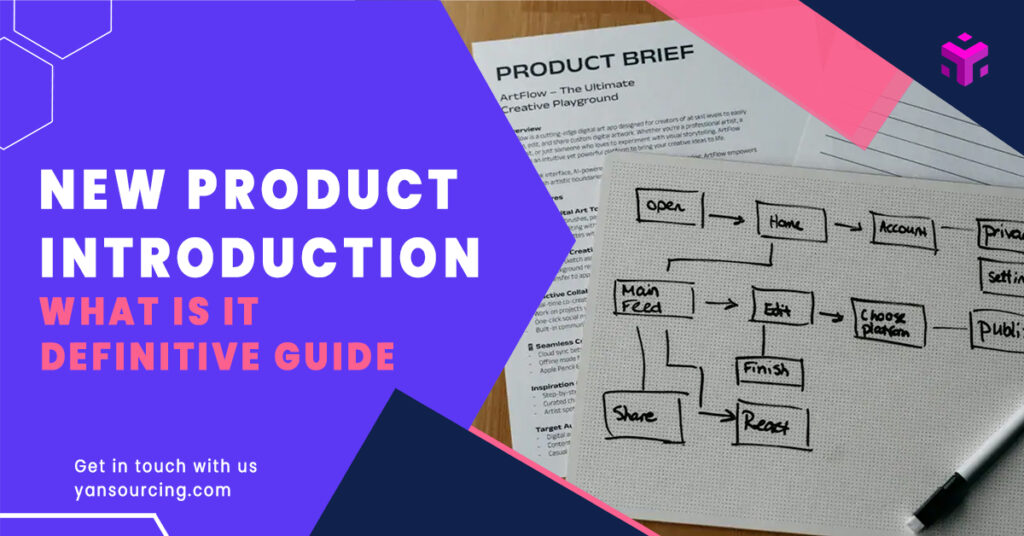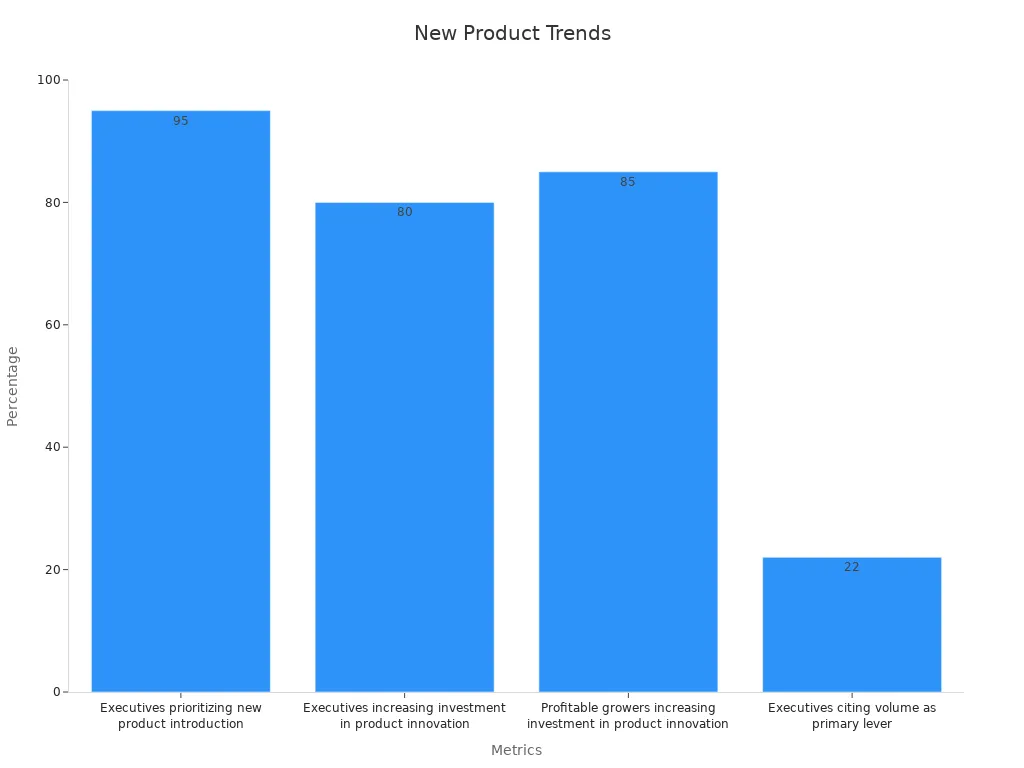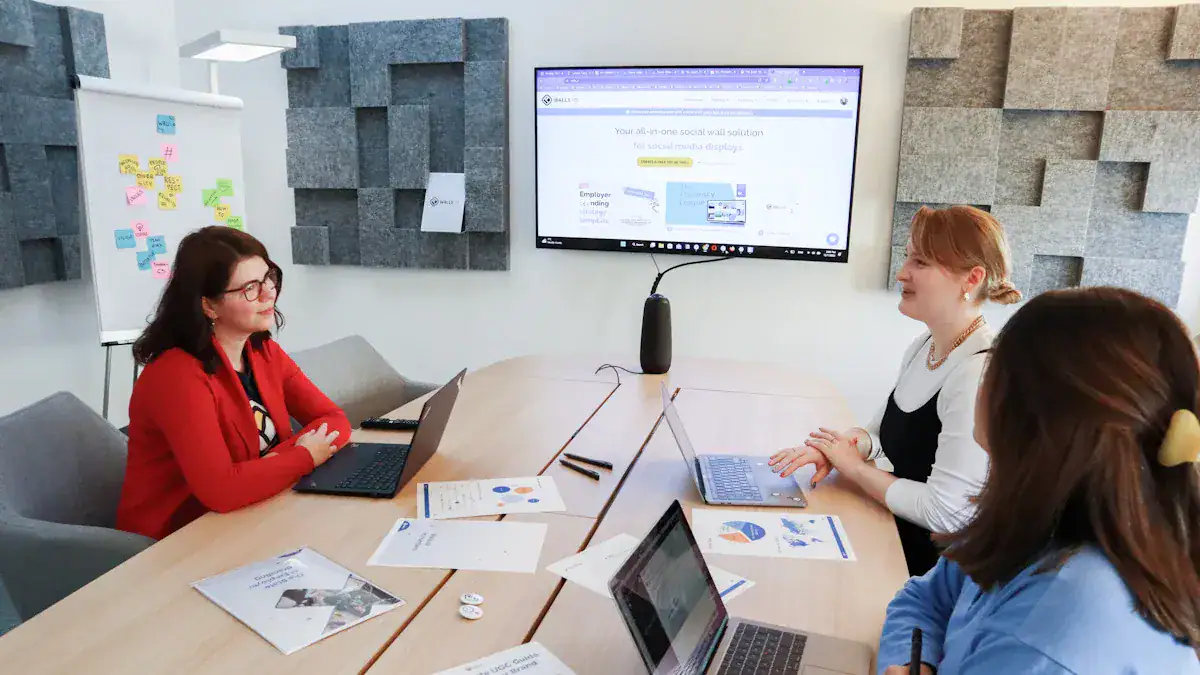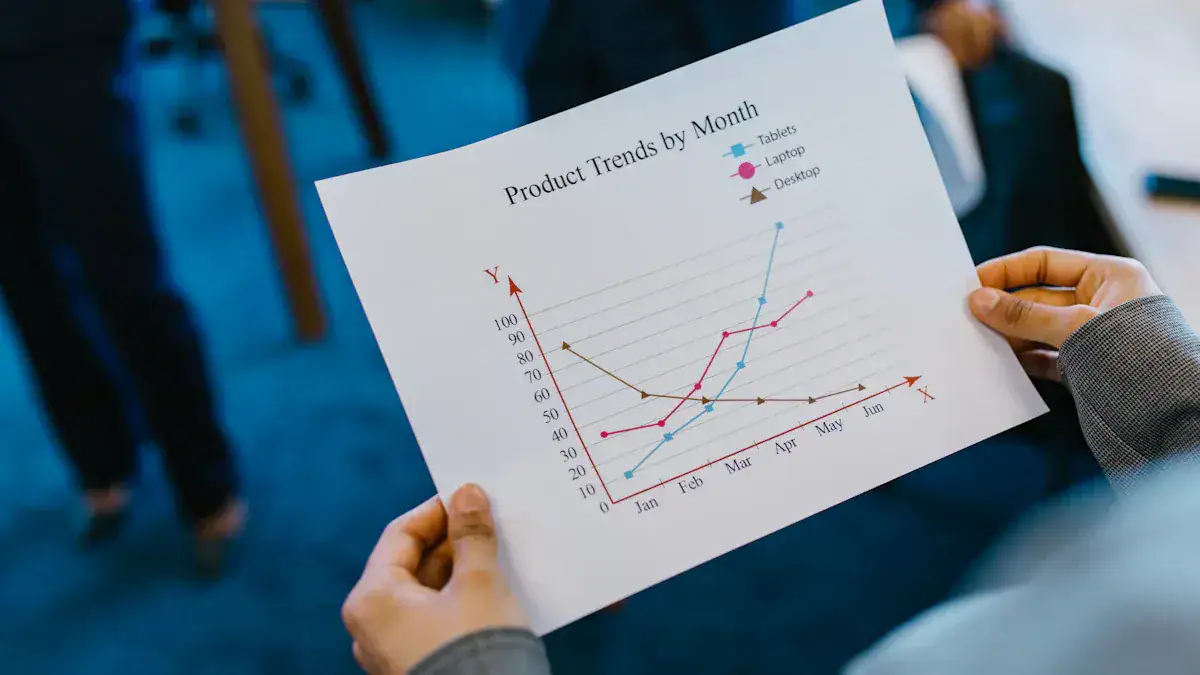
New product introduction means turning an idea into a product. It helps businesses create new things and stay competitive. Did you know only 40% of products succeed in the market? This is why doing it correctly matters a lot. Yansourcing helps businesses make this process easier. From finding materials to creating products, they ensure it fits market needs well. Are you ready to make your ideas real?
Key Takeaways
New Product Introduction (NPI) helps turn ideas into products customers want.
Study the market to learn what customers like and make your product unique.
Making and testing prototypes finds problems early, saving time and improving quality.
Working with experts like Yansourcing makes NPI easier and faster.
Use customer feedback and data to improve your product and make people happy.
Understanding New Product Introduction
What Is New Product Introduction?
New Product Introduction (NPI) is the process of turning an idea into a product ready for the market. It’s not just about making something new. It’s about making sure the product solves problems, fits your business goals, and does well with customers. Think of it as a step-by-step guide to go from an idea to a product that stands out.
Why is this important? Without a clear NPI plan, businesses might waste time, money, and effort on products that don’t work for their customers. For example, using tools like surveys and A/B testing helps companies know what customers like. These tools show what works and what doesn’t, so your product can succeed.
In short, NPI helps turn ideas into successful products. It’s the key to creating new things and staying ahead in today’s competitive world.
Key Objectives of the NPI Process
The NPI process isn’t just about making a product. It’s about making the right product. Here are the main goals:
Customer-Centric Design: Your product should solve a real problem. To do this, you need to understand your audience through research and feedback.
Quality Assurance: Your product must meet high standards. Testing and checking are very important steps.
Cost Efficiency: You need to balance quality and cost. The NPI process helps you use resources wisely, from materials to production.
Faster Time-to-Market: Speed is important. A good NPI process helps you launch quickly without losing quality.
Market Readiness: Your product should be ready to compete. This includes packaging and marketing plans.
To track these goals, businesses use Key Performance Indicators (KPIs). These include things like customer satisfaction, testing success, and production readiness. Here’s a table showing how NPI stages match with measurable results:
Stage | Measurable Indicator |
|---|---|
Ideation | Number of ideas created |
Market Research and Analysis | Customer needs found |
Design and Prototyping | Number of prototypes made |
Design Validation and Testing | Testing success rate |
Pre-Production to Mass Production | Production readiness level |
Launch and Post-Launch Evaluation | Customer satisfaction scores (CSAT) |
By focusing on these goals, you can make sure your product not only reaches the market but also succeeds.
Why NPI Is Crucial for Businesses in 2025
In 2025, staying competitive means being creative. Businesses that focus on New Product Introduction can better handle changing customer needs and market trends. Here’s why NPI matters more than ever:
Rising Consumer Expectations: Customers want products that are useful, eco-friendly, and personalized. The NPI process helps you meet these needs by using feedback and trends in your designs.
Increased Competition: More companies are entering the market, making it harder to stand out. A strong NPI plan helps your product be unique and valuable.
Technological Advancements: New tools like 3D printing and automation make product development faster and cheaper. Using these tools in the NPI process can save time and money.
Think about this: 95% of business leaders now focus on new product introduction, and 80% are spending more on product innovation. These numbers show how important NPI is for success.

Also, businesses that do well in NPI often see big improvements. Checking KPIs like market share, revenue, and feature use can help you see progress and make better decisions.
In short, NPI isn’t just a process—it’s a must-have. It helps you stay ahead, meet customer needs, and grow your business in a fast-changing world.
Steps in the NPI Process

Ideation and Concept Development
Every great product begins with a simple idea. Ideation is where you think of new ideas. Concept development turns those ideas into clear plans. This step mixes creativity with planning.
You need to find gaps in the market. Look for problems that need solving. For example, studying customer complaints or checking competitors can show what’s missing. Once you spot these gaps, use tools like mind maps to create ideas. Working with others helps bring fresh perspectives and stronger plans.
After brainstorming, pick the best ideas. Focus on what’s possible and what people want. Ask yourself: Does this idea match your goals? Will customers like it? A good review process saves time and effort on bad ideas.
Next, create simple prototypes to test your ideas. These early models show how your product might work. Quick feedback from users helps improve your design. For instance, testing an eco-friendly product with green shoppers can confirm its appeal.
Here’s how structured ideation helps your product:
Benefit | Description |
|---|---|
Identifying Market Gaps | Spot problems by studying customer needs and competitors. |
Brainstorming and Generating Ideas | Use tools like mind maps to create diverse ideas. |
Evaluating and Selecting Ideas | Choose ideas based on what’s possible and in demand. |
Prototyping and Concept Testing | Test ideas with users to get quick feedback. |
Advancing Ideas to Development | Align good ideas with goals to use resources wisely. |
Tip: Follow trends like eco-friendliness or personalization to stand out. Use tools to predict future needs and plan ahead.
Market Research and Feasibility Analysis
Before making a product, check if it will work. Market research and feasibility analysis answer key questions: Do people want this? Who are your competitors? Can you afford to make it?
Start by learning about customer likes and market trends. Tools like Google Trends can show what’s popular. Surveys and interviews help you understand what people need. For example, if you’re making a gadget, research can show which features matter most.
Feasibility analysis goes deeper. It checks if your idea is practical and affordable. This includes costs, possible earnings, and production challenges. A market study combines customer data, competition, and finances to guide decisions.
Timing matters. Do research before designing, during development, and after launch. This keeps your product in line with market needs. Here’s a breakdown of market research steps:
Aspect | Description |
|---|---|
Importance of Market Research | Learn user needs and market trends to ensure success. |
Types of Research | Use concept testing, usability studies, and market analysis. |
Timing of Research | Research before, during, and after development for better results. |
Success Indicators | Watch user behavior and market trends for opportunities. |
Tools for Research | Use tools like Google Trends to gather and study data. |
Note: Research isn’t just about collecting data. It’s about using it to make smart choices. The more you know, the better your product will fit customer needs.
Design and Prototyping
Design and prototyping turn ideas into real products. This step helps you test and improve before full production.
Start with a clear plan. Focus on features that solve problems. For example, if making a Bluetooth speaker, focus on sound and portability. Make sure the product is easy to use and enjoyable.
Rapid prototyping is very helpful. It lets you make quick, low-cost models to test ideas. Tools like 3D printing make this faster and cheaper. You can try different designs without spending too much.
Testing is key. Early prototypes help find problems quickly. Get feedback from users to improve your design. For instance, testing a toy with kids shows if it’s fun and strong. This process ensures your product is ready before production.
Here’s why prototyping is important:
It finds problems early, reducing risks.
It saves money by avoiding big mistakes.
It improves quality through constant updates.
Tip: Take your time with prototyping. A well-tested design makes production easier and smoother.
Validation and Testing
Validation and testing are key to a successful product launch. This step checks if your product works well, meets customer needs, and follows rules. Think of it as the last check before production begins.
In this stage, you focus on two main tasks: design validation and user testing. Design validation makes sure your product matches its original purpose. For example, if you’re making a Bluetooth speaker, you’ll test sound, battery life, and strength. User testing involves real people trying your product. Their feedback shows what’s easy to use and what needs fixing.
Did you know? Testing early catches problems before they grow. This saves time, money, and improves customer happiness.
Here’s how testing helps make products reliable:
Metric | Value |
|---|---|
85% usage rate | |
Load Times | 2.5 seconds on average |
Bug Frequency | 5 major bugs per 100 uses |
To learn more, use surveys and interviews. These tools show what users like and dislike. For example, quotes from testers can point out issues, while feedback gives clear ideas for changes.
Tip: Take your time with testing. A well-checked product has a better chance of success. Quality is always more important than speed.
Manufacturing Preparation
After passing testing, it’s time to prepare for manufacturing. This step focuses on making production smooth, saving money, and keeping quality high.
Start by checking your machines and processes. Tools like Overall Equipment Effectiveness (OEE) show where things can improve. For instance, if machines aren’t working at full speed, you’re wasting time and money. Fixing these problems can save costs and speed up production.
Metric | Description | Impact on Production Time and Costs |
|---|---|---|
Overall Equipment Effectiveness (OEE) | Measures how well machines are used. | Finds problems, cutting downtime and costs. |
Changeover Time | Time to switch between products. | Faster switches mean fewer delays. |
Waste Reduction | Using fewer materials and less time. | Cuts costs and increases material use. |
Next, work on changeover time. This is how fast you can switch from making one product to another. Faster changeovers mean less waiting and more flexibility. For example, if you’re making different versions of a Bluetooth speaker, quick switches save hours.
Finally, focus on reducing waste. Use only what’s needed and recycle when possible. This saves money and helps the environment.
Pro Tip: Work with experts like Yansourcing to improve your process. They help with sourcing and logistics, making production easier.
Product Launch with Yansourcing’s Consumer Products
The big moment is here—your product launch. This is when all your hard work pays off. But launching a product needs careful planning and effort.
Start by creating excitement. Use social media and emails to spread the word. Show off your product’s best features. For example, if you’re launching pet supplies, explain how they solve common pet owner problems.
Yansourcing can help make your launch smoother. They specialize in sourcing high-quality products, from bags to electronics. They handle quality checks and shipping, so you can focus on selling and promoting.
Why choose Yansourcing? Their all-in-one services make the process simple. They ensure your product is ready for the market and delivered on time.
After launching, don’t forget to review how it went. Check customer feedback, sales numbers, and market trends. This helps you find ways to improve and plan your next steps.
Note: A good post-launch plan keeps your product popular. Always listen to your customers—they give the best ideas for improvement.
Benefits of Implementing NPI

Faster Time-to-Market
Getting products out quickly changes everything. A good New Product Introduction (NPI) plan finds delays early and fixes them fast. This helps you launch faster without losing quality. For example, clear steps for each phase keep everyone focused.
NPI also stops team handoff mistakes. Organized records make moving from design to production easier. Imagine smooth transitions that save time and avoid confusion. This speeds things up and keeps teams working on what matters—making great products.
Benefit | Description |
|---|---|
Organized records make moving from lab to production easier. | |
Faster Time to Market | Clear steps help find and fix delays early. |
Standardized Procedures | Uniform lab methods ensure results are easy to repeat and track. |
Tip: Use tools like project trackers to spot problems early and stay on schedule.
Improved Product Quality
Quality matters most when winning customers. The NPI process focuses on quality from the start. This means fewer mistakes and better products. For example, tracking defect rates shows weak spots in production. Fixing these problems early keeps customers happy.
Testing is super important. Checking your product at every step ensures it meets high standards. Metrics like scrap rates and Cost of Quality (CoQ) show how well your process works. For instance, lower scrap rates save money and prove your production is efficient.
Metric | Description | Usage |
|---|---|---|
Cost of Quality (CoQ) | Includes costs like scrap and warranties. | Use CoQ data to find areas needing improvement. |
Defect Rate | Measures defective parts per million (DPPM). | Find problem stages and improve production. |
Scrap Rate | Shows wasted materials during production. | Fix processes causing waste to save money. |
Note: Better quality means fewer complaints and happier customers.
Cost Efficiency and Resource Optimization
Saving money while working smarter is a big win. NPI helps you find ways to cut costs early. For example, using energy-saving machines or lean methods reduces waste and saves money.
Technology helps too. Tools like ERP systems automate tasks, lowering labor costs. Route planning software cuts fuel use and improves deliveries. These small changes make operations cheaper and smoother.
Here’s how NPI saves money:
Tracking products avoids inventory problems and makes recalls easier.
Lean methods cut waste and use resources wisely.
Recycling saves money and helps the planet.
Pro Tip: Use eco-friendly tools to save money and attract green-minded customers.
Enhanced Customer Satisfaction with Yansourcing’s Expertise
Yansourcing knows how to make customers happy. Their skills in sourcing and product creation focus on quality and meeting needs. Whether it’s a new gadget or pet supplies, Yansourcing helps your product shine.
How do they do this? First, they focus on quality checks. Every product is inspected carefully to meet high standards. This means fewer problems and happier buyers. For instance, if you’re selling toys, Yansourcing ensures they are safe and strong. Parents can trust your brand because of this.
Second, they offer ways to customize. Imagine making a product that feels special for your audience. Yansourcing helps adjust designs, packaging, and materials to fit customer needs. This personal touch makes people loyal and keeps them coming back.
Lastly, Yansourcing handles shipping and storage. They make sure products arrive on time and in great shape. This reliability makes customers happy because no one likes late deliveries.
Here’s why Yansourcing’s method works:
Quality Assurance: Strict checks mean fewer complaints.
Customization: Special designs make customers feel important.
Efficient Logistics: Fast delivery keeps buyers satisfied.
Tip: Let Yansourcing handle the details while you grow your business. Happy customers lead to better reviews, more sales, and a stronger brand.
Choosing Yansourcing doesn’t just improve your product. It creates an experience your customers will enjoy and remember.
Best Practices for a Successful NPI

Working Together as a Team
Teamwork is key for New Product Introduction (NPI) success. Teams with people from different areas, like marketing and engineering, work best. They solve problems faster and make better products. Sharing ideas brings new thoughts and leads to creativity.
For instance, marketing knows what customers want. Engineering handles how to make it work. Together, they ensure the product is useful and works well. Talking openly is very important. It avoids delays and keeps everyone on track. Without teamwork, launches can fail. But working together makes things faster and helps your product succeed in the market.
Teams also help you handle surprises. If a competitor makes a similar product, your team can quickly change plans. This makes your product stronger and more competitive.
Using Data to Make Smart Choices
Data helps you make better decisions for new products. It shows what works and what doesn’t. Dashboards let you see progress and fix problems fast. Predictive tools show future trends, so you can plan ahead. Clean data makes sure your choices are correct.
Using data increases success. Companies using data gain more customers and keep them longer. They also make more money. These facts show how helpful data can be.
Feedback is also important. If customers ask for a feature, you can add it during development. This keeps your product useful and makes customers happy.
Being Fast and Flexible
Agile methods make work faster and easier. Instead of waiting for a perfect product, you release small updates and improve them. This saves time and focuses on what customers need. Many companies now use agile methods for this reason.
Iterative processes work the same way. You test, get feedback, and fix problems. For example, testing a prototype with users shows issues early. Fixing them before production saves time and money.
These methods also help you adjust to changes. If trends change, you can quickly update your product. This keeps you ahead of competitors and ensures your product stays popular.
Partnering with Experts Like Yansourcing
Launching a new product is easier with the right help. That’s where Yansourcing comes in. They make New Product Introduction (NPI) simple and help you avoid mistakes. You can focus on your ideas while they handle the hard parts.
Yansourcing finds trustworthy suppliers for your product. They check factories, confirm certifications, and ensure high quality. This means no worries about bad suppliers or poor materials. They also get better deals, saving you both time and money. Think of them as experts who know the market and work to get you the best results.
Here’s how Yansourcing stands out:
Advantage | Description |
|---|---|
They find trusted suppliers to keep your supply chain strong. | |
Quality Assurance | Factory checks and certifications ensure top-notch quality. |
Cost Management | Skilled negotiators save you money and time. |
Risk Mitigation | Testing samples and following rules lower risks for your product. |
Yansourcing also reduces risks by testing samples and following regulations. This helps avoid costly problems during production or launch. Their logistics support ensures your product gets to market on time.
Tip: Let Yansourcing handle the tricky details. This gives you more time to grow your business. Their skills make launching faster, smoother, and more successful.
With Yansourcing, you get a partner who turns ideas into winning products. Why do it alone when experts can help you succeed?
Conclusion
New Product Introduction is a guide to turn ideas into products. Steps like brainstorming, testing, and preparing for production help make items customers want. This process speeds up launches, improves quality, saves money, and keeps buyers happy.
In 2025, businesses must adapt to customer habits and use new tools. A clear NPI plan grabs attention and improves products over time. This helps people buy more and stay loyal, keeping your business strong in a changing world.
Yansourcing makes this easier. They handle materials and shipping, simplifying each step. Their skills ensure your product is market-ready for a smooth launch.
Tip: Work with experts like Yansourcing to focus on ideas while they manage the details.
FAQ
1. What is the main purpose of New Product Introduction (NPI)?
NPI helps turn ideas into products people want. It makes sure your product solves problems, is high quality, and launches smoothly. By following clear steps, you avoid mistakes and bring new ideas to market faster.
2. How does Yansourcing support the NPI process?
Yansourcing makes NPI easier by managing sourcing, quality checks, and shipping. They find trusted suppliers, ensure your product meets standards, and handle delivery. This lets you focus on creating while they manage production details.
3. Why is prototyping important in NPI?
Prototyping lets you test and improve your product early. It finds design problems quickly, saving time and money. Tools like 3D printing help make models fast, get feedback, and make your product better for customers.
4. How can NPI reduce production costs?
NPI finds ways to save money in design and production. It improves how materials and processes are used. For example, lean methods or expert sourcing, like Yansourcing, can lower costs and boost efficiency.
5. What makes Yansourcing a trusted partner for product launches?
Yansourcing is skilled at finding quality materials, checking products, and managing shipping. They help you customize items, avoid risks, and launch successfully. With Yansourcing, you have a partner focused on your success.
Tip: Working with experts like Yansourcing saves time, money, and effort during your launch.

